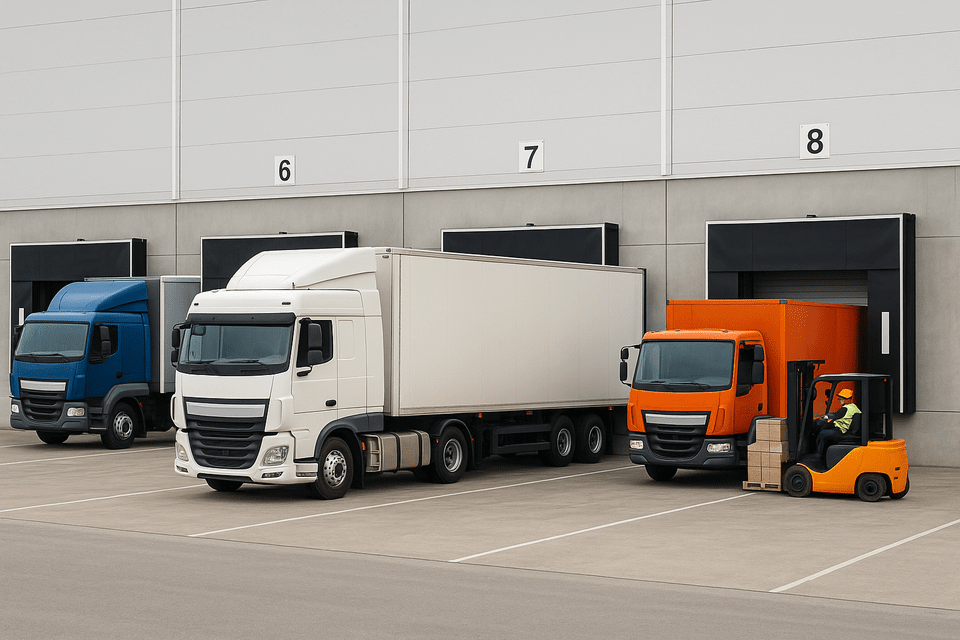Sep 30, 2025 Zdravka Ley
ShareThe issue of driver shortages has been the subject of heated debate for years. In Germany alone, there is an estimated shortage of 40,000 to 60,000 truck drivers every year. However, an equally pressing and often underestimated problem is the shortage of logistics personnel in warehouses and at loading docks. Staff shortages, scarce shift coverage, and last-minute absences on the day of deployment exacerbate the bottleneck at the loading dock, which sets the pace for the entire material flow. Without intelligent loading dock control, yard and production logistics quickly become unbalanced. The result: waiting times, demurrage charges, and delivery delays.
Why the ramp becomes a bottleneck
Transport, warehousing, and production all come together at the ramp. Even small delays, such as when several trucks want to be unloaded at the same time or there is a shortage of staff, are enough to bring the process to a standstill. Ramps and parking spaces quickly become blocked, while employees come under pressure.
In addition, many locations have limited loading and buffer space. This leads to congestion, demurrage charges, and, in the worst case, interruptions in production supply. This results in additional costs and frustration for carriers, shippers, and suppliers alike. Although a time slot schedule provides an initial structure, the reality is different: trucks arrive too early, too late, or at the same time.
Limitations of traditional time slot scheduling
Time slot management is an important component in planning ramp utilization. However, it is not enough on its own to avoid waiting times – especially if there are shortcomings in ramp management. In practice, trucks often arrive outside their booked time slot or bring a different quantity of freight. If the availability of personnel, forklifts, and storage space is not taken into account when booking time slots, the plan will be ineffective. Without intelligent real-time adjustments, careful planning quickly becomes an organizational bottleneck with no effect.
The solution: Intelligent ramp management
Ramp management encompasses all processes related to loading and unloading at loading ramps: from the arrival of the truck to the allocation of the correct ramp and the optimal use of personnel and space.
Modern yard management systems such as SYNCROSUPPLY combine time slot planning with yard management. They record the status of all trucks, ramps, parking spaces, and employees and continuously calculate the best loading and unloading sequence.
The system reacts immediately to deviations, such as delays, changed loads, or short-term staff shortages:
- Staff deployment: Available employees are deployed where they are most urgently needed in order to avoid idle time and overload.
- Space use: Buffer areas and parking spaces are dynamically allocated to prevent traffic jams.
- Flexibility: Delays or changes in loading volume automatically result in a new, optimal ramp sequence.
Miele shows how this works in practice. The company used to plan the entire truck delivery process using Excel lists. There was hardly any transparency. Carriers and suppliers only announced their deliveries for a specific day. With this type of organization, it was almost impossible to reliably plan resources in advance. At the Gütersloh plant alone, with 20 loading ramps and 8 forklifts, this regularly led to delivery peaks: several trucks arrived at the same time, ramps and parking spaces were blocked, and employees at the gate had to make numerous phone calls to clarify where a vehicle could dock and when personnel and forklifts were available. With the increasing number of deliveries, efficient processing was no longer possible manually.
The introduction of the SYNCROSUPPLY yard management system, which combines time slot management and optimized ramp management, has fundamentally improved the entire delivery process. Carriers book their time slots online, and ramp occupancy and personnel deployment are automatically taken into account. In the event of deviations, such as late arrivals or changes in freight volumes, the system calculates a new handling plan in seconds. This helps to smooth out delivery peaks, reduce waiting times and demurrage charges, and reliably secure production supplies.
This turns ramp management into an active control tool rather than just a planning basis. Trucks, personnel, and ramps come together at exactly the right time, even when unexpected events occur.
Advantages of modern ramp management
Intelligent ramp management reduces waiting times, avoids demurrage charges, and significantly improves adherence to delivery schedules. Even when personnel and space capacities are limited, the combination of time slot planning and yard management ensures that all resources are used optimally.
The result:
- Greater resource efficiency – less idle time, less overload.
- More stable processes – even with short-term changes to plans.
- More reliable production supply – materials arrive on time when they are needed.
Those who control the ramp intelligently can manage the entire yard logistics process and achieve maximum efficiency even in the event of unforeseen circumstances.
Are you ready to eliminate ramp bottlenecks in your company?
About our Expert

Zdravka Ley
Marketing Manager
Zdravka Ley started working for INFORM in 2002 and is focused in topics around the optimization and sustainability of delivery and internal transport logistics.



